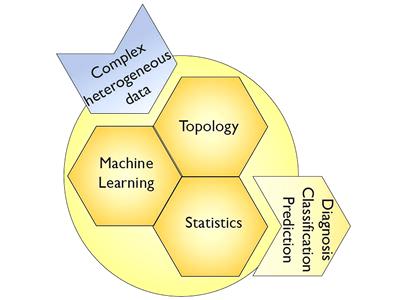
Topological data analysis (TDA) has become an important part of the modern data science, complementing machine learning and statistics as a new and powerful approach to data analysis. The Joining the Dots programme, sponsored by the EPSRC, is dedicated to creating a fusion of the three strands of data science to provide a focus for the development of new methodologies that are equal to the challenge of complex, heterogeneous, multidimensional data.
The JTD group was set up as a centre for multidisciplinary research crossing the boundaries of mathematics, statistics, computer science, by brining new theory and algorithms into close contact with exciting and challenging problems in medicine, biology, and the sciences. We are open to new collaborations, visitors, and contact from industry and commerce. In time, we intend the Joining the Dots initiative to grow to provide a national focus point for activity in the area of the study of the foundations and applications of Topological Data Analysis.
We are planning a series of workshops, conferences, and instructional events from 2017-2019, and details will be available on this site.
This programme is initially focussed on the following themes, and we expect the list to grow with the progress of our work
- Theoretical foundations of mapper-type techniques, including the problems of stability of mapper outputs and, in general, of clustering procedures.
- The theory and applications of persitent homology; interactions between mapper and persistent homology.
- Geometric and topological foundations of tensor factorisation
- Geometric data analysis; synchronisation problems, vector bundle representation of hidden symmetries of data, extensions of de Rham theory and spectral methods to group actions and symmetries
- Topological features of deep neural networks
- Topological analysis of time-series and general time-dependent systems
- Persistent homology of molecular systems, the structure of chemical space, topological methods in drug discovery
- Topological data analysis of ‘omics data; topological classification of asthma phenotypes, discovery and validation of biomarkers. This part of our programme is carried out with the U-Biopred consortium, an EU-funded leading international consortium dedicated to the study of asthma.
- Statistical methods in topological data analysis: confidence intervals in persistence diagrams, probabilistic techniques, persistent homology transform
- Topology and optimisation: applications of topological data analysis in decision making processes